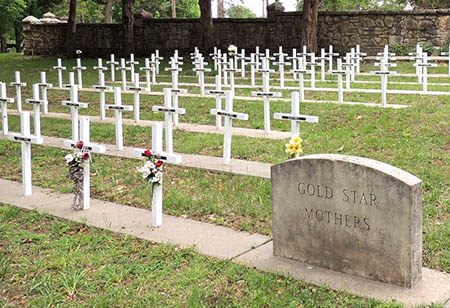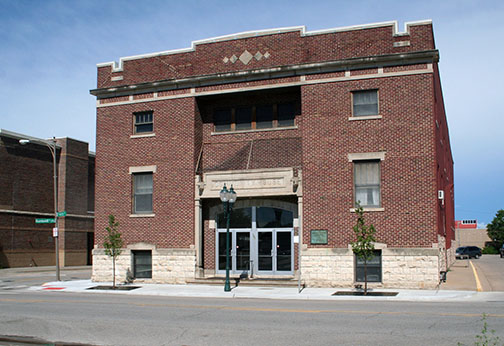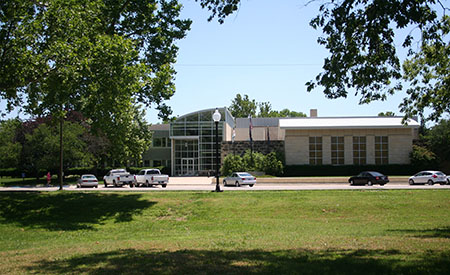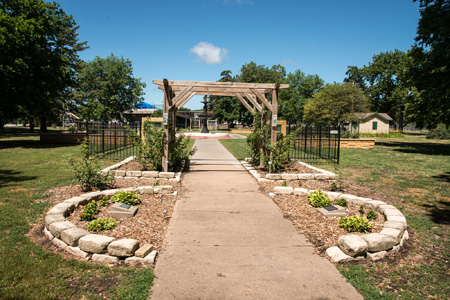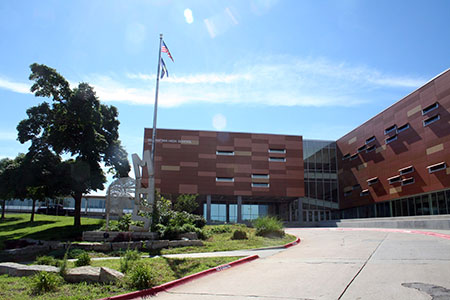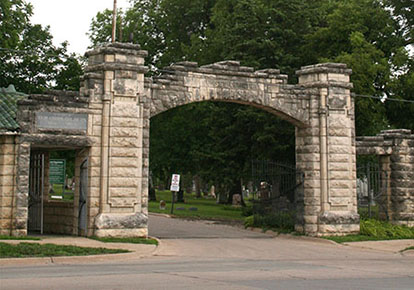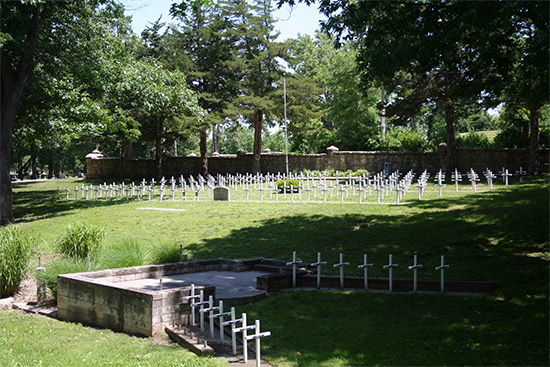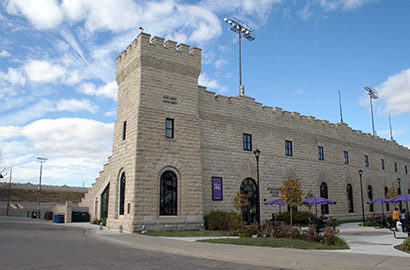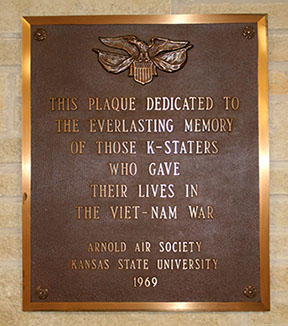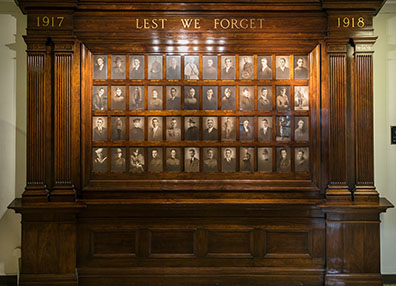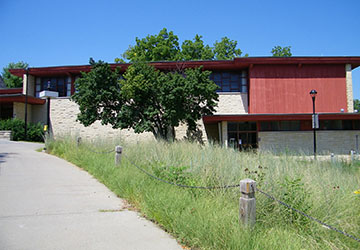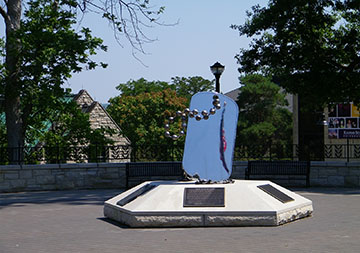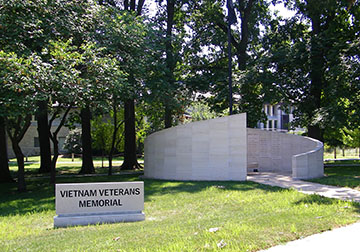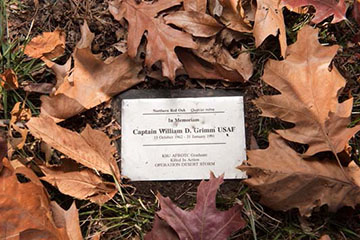Walking Tour of Manhattan's Memorials
November 11th is celebrated as Veteran’s Day each year. The day is a special day of remembrance to honor those that served our nation’s armed forces, but you can honor America’s veterans on any day. Take the Walking Tour of Manhattan’s Memorials and visit the twenty-three monuments and memorials in Manhattan’s city limits. Google Maps indicates that you can cover the distance of approximately 5.2 miles in one hour and 48 minutes, but plan for a bit longer to allow for time to view the monuments. It is, of course, also possible to drive the route. Parking is available at all locations. For the monuments on the Kansas State University campus, the parking garage would be the best location to leave your car.
Begin the walking tour at Humboldt and Fourth Streets. A short walk will bring you to the first memorial.
Community Building
The Community House is a brick building, which was designed as a recreation center for soldiers. It has a bronze plaque mounted to the right of the front door that reads, "1917 Manhattan - Camp Funston Community Building, A Tribute From The Citizens Of Manhattan And The Rotarians Of Kansas, Missouri And Oklahoma To Our Soldiers, ‘He Profits Most Who Serves Best.’” In 1941, the Community House was “permanently dedicated to the soldiers of that war,” meaning World War I.
From the Community House, head south on North Fourth Street and then turn right on Poyntz Avenue and head west to the Riley County Courthouse (0.1 mile, 3 min.). Two monuments are in front of the Courthouse.
The Eagle Monument and Riley County Veterans Monument
The Eagle Monument is in honor of “All American Veterans” who are “forever the symbol of heroism, sacrifice, loyalty, and freedom.” The adjacent granite monument is dedicated to “those brave individuals from Riley County who honorably served in the armed forces.”
Cross the street and head west on Poyntz Avenue (0.6 miles, 12 min.), to reach the City Hall and Peace Memorial Auditorium complex.
Peace Memorial Auditorium
The building is a “living” memorial, dedicated to the 2,610 Riley Countians who served in World War II, the 101 who lost their lives, and to the county’s early settlers.
The foyer of Peace Memorial Auditorium honors the 101 servicemen that made the ultimate sacrifice in World War II. It features a kiosk with historical information, and the memorial wall displays the names of the Riley Countians killed in World War II, a Purple Hear, a gold star, and the Soldier’s Cross, also known as the Fallen Soldier Battle Cross.
Cross the street from City Hall and take a walk to the Rose Garden just north of the playground and splash park. (0.1 mile, 1 min.)
Pearce and Keller Veteran Memorials
The American Legion in Manhattan is named for two local veterans who died in France while fighting as part of the American Expeditionary Force during the First World War: Lieutenant Clede R. Keller and Captain Willis L. Pearce. Both men are honored with plaques located at the entrance the City Park's Rose Garden. Click on the image to the right to view their plaques.
Captain Willis Leroy Pearce, Sr. was born in 1882 in Smith Center, Kansas. Pearce served as an officer in Company F, 142nd Infantry, 36th Division. He was killed in action on October 8, 1918 while serving in the 36th Division's efforts to push the enemy from the area north of St. Etienne-a-Arnes (specifically, Hill 140) back to the Aisne River. Awarded the French "Croix de Guerre" (Cross of War).
First Lieutenant Clede Rex Keller was born on March 15, 1892 in Webb City, MO. He died on September 29, 1918 in the Argonne Forest, France. Keller's military service began on March 10, 1911 as a private in the Kansas National Guard Company First Regiment at Manhattan, Kansas. He was commissioned Second Lieutenant by Kansas Governor Arthur Capper on February 4, 1915. Keller was later promoted, on October 1, 1915, as First Lieutenant of Cadets at the Kansas State Agricultural College. During the latter part of 1916, he saw active service on the Mexican border. He was mustered into federal service, on August 5, 1917, and received a first Lieutenant commission in April of 1918. Keller's service in France was with the 137 Infantry Regiment 35th Division. Lieutenant Keller died of wounds received in action on September 29, 1918 and is buried at the Meuse-Argonne American Cemetery in Romagne, France.
Spanish-American War Monument and Union Soldier Monument
A little further north from the Rose Garden stands a Pioneer Log Cabin in the vicinity of the City Pool. There are two cement cannon mounts in front of the Pioneer Log Cabin in the City Park: the Union Soldier Monument and the Spanish-American War Monument.Both cannons were removed for a World War II scrap metal drive.
The north mount has a bronze plate that reads, "Dedicated to the memory of the Spanish American War Veterans 1898-1902 by the Wilbur Samuels Auxiliary No. 13 Dept. of Kansas N.A.U.S.W.V. Oct 27 - 1937.”
The south mount has a corresponding dedication that reads, "Dedicated to the Union Soldier 1861-1865 by the ladies of the Grand Army of the Republic Manhattan Circle No. 45 Jan 2, 1937.”
The dates on the Spanish-American War Monument extend a couple of years past the end date of the war, which indicates that at the time of placement, the Philippine Insurrection was considered part of the Spanish-American War. The Spanish-American War took place in April through August 1898. The Philippine Insurrection lasted officially until 1902 (fighting continued until 1905). Brigadier General Frederick Funston captured the Philippine leader Emilio Aguinaldo in 1901, and the war was declared officially over the next year.
Head back towards City Hall and head west on Poyntz Avenue towards Sunset Hill, Sunset Zoo and the Manhattan High School West Campus (0.9 miles, 18 min.) until you are in front of the school.
Enter the front door, and the administrative offices are on the left. The staff can provide access to the memorial plaques in the building.
The Manhattan High School Alumni Conference Room Memorial Plaques
Plaques honor students that gave their lives in World War I and World War II.
Head east on Poyntz and turn left on Sunset Avenue (0.2 miles, 4 min.) to reach the entrance to Sunset Cemetery.
The Union Soldiers' Arch
The memorial arch provides an entrance to the cemetery. A stone tablet above the left entryway is inscribed, "In Memory Of Our Union Soldiers 1861-1865 Erected By Womans Relief Corps And Citizens - 1917.”
Walk west through the arch, and after a few meters, you will discover a large cannon on the left side of the main road. This is the first of four stops inside the cemetery. Total round trip distance from the arch and back is approximately 1.0 mile, 22 min.
Defenders of the Union Monument
The monument consists of a large stone base that supports the cannon. The base is inscribed, "Erected 1898 By Lew Gove Post Grand Army of the Republic, Womans Relief Corps, In memory of the defenders of the Union. 1861-1865.”
The cannon is a 6.4" Navy Parrott heavy rifle. References indicate that it served on and sank with the gunboat Otsego, which hit a mine in the Roanoke River on Dec. 9,1864. The cannon was recovered, but saw no further service. During World War II scrap metal drives, reportedly the community agreed to spare this cannon in exchange for sacrificing the two adjacent to the Pioneer Log Cabin. The monument is surrounded by the graves of 20 Union soldiers.
Continuing west on the main road, the next memorial is the Memorial Day Platform.
Memorial Day Platform and Flagpole - Sons of Union Veterans, and Union Soldiers’ monument
The platform is just past the first small stone culvert. Take the first road on the left before the Wareham mausoleum. A plaque at the base of the flagpole is engraved, "Erected in 1934 by the R. B. Spilman Camp of the Sons of Union Veterans." The platform is difficult to find, as it is sometimes overgrown with bushes.
Adjacent to the platform is the Union Soldiers’ monument, which is inscribed, “Union Soldiers 1861-1865, Erected by Manhattan Post No. 217, Grand Army of the Republic.
The Gold Star Mothers’ Monument and Riley County Sunset Memorial and Platform
The Riley County Sunset Memorial was originally established after World War II by the American Legion in honor of the Riley Countians killed in the war. Commemorative crosses honor local service members’ sacrifice. A flagpole is located in the center. The area includes a Gold Star Mothers’ monument and an anti-tank gun. Toward the rear, there is a gray monument of Vermont marble with a single gold star on it, a sundial on the top to represent the passage of time, and the insignia of the American Legion on it. The inscription reads, “We remember our brave sons who died for you.”
The American Legion War Memorial is a platform and includes a group of crosses that list America’s wars from the American Revolution to the present. The crosses commemorate the Revolutionary War, the War of 1812, the Mexican War, the Civil War, the Spanish-American War, World War I, World War II, Korean Conflict, Vietnam, Grenada/Lebanon, Panama, Desert Storm, Buried at Sea, and Missing and Unknown.
At this point, head back to the arch and turn north on Sunset Avenue to Anderson Avenue. At Anderson Avenue, cross the street and take a right, walking towards the KSU Campus. Walk 0.5 mile, 11 min. to reach World War I Memorial Stadium. The Memorial Stadium is one of nine veterans’ monuments or memorials located on the Kansas State University Campus.
World War I Memorial Stadium
The stadium was constructed in the 1920s to honor the 48 Kansas State students and alumni who died in World War I. It was originally intended to be a horseshoe design, but the arc of the horseshoe was never completed, and it was not dedicated. In April 2017 on the 100th anniversary of the U.S.’s entry into World War I, Memorial Stadium was officially dedicated. The stadium was the first memorial on campus. Identical plaques commemorating veterans are located on the south ends of both West Stadium and East Stadium.
From Memorial Stadium, cross the street, heading northeast and enter the K-State Student Union. Go to the second floor to find the Vietnam Veterans’ plaque.:
Vietnam War Plaque
Before the Vietnam Veterans Memorial was built, a memorial plaque was donated to the university in 1969 and placed on the first floor of the K-State Student Union to honor those students who died in the Vietnam War. In 2017, the plaque was moved to outside the Veteran’s Resource Center on the second floor.
From the K-State Student Union building, head north on north 17th street (0.4 miles, 8 min.) to General Richard B. Myers Hall. Myers Hall is the Military Science Building and houses three memorials. Two of the memorials are display cases, and the material on exhibit rotates. The third memorial may be found on the lower level of Myers Hall.
World War I Memorial Wall
The World War I Memorial Wall, with the title "1917 – Lest We Forget – 1918," is in the lower level hallway of Gen. Richard B. Myers Hall. The memorial includes the portraits of the 48 K-State men who died in World War I.
The photographic memorial was dedicated in 1929 and was originally planned to be installed in the main entrance to Memorial Stadium, which was intended to be located in the arc of the horseshoe. The horseshoe shape of the stadium was never completed, and the memorial wall was placed in Anderson Hall. In later years, the memorial wall was stored beneath Memorial Stadium and forgotten about until it was rediscovered approximately 2000-02. After undergoing restoration, the memorial wall was moved to Gen. Richard B. Myers Hall.
From Myers Hall, head south and east (0.5 miles, 11 min.) to Danforth Chapel and All Faiths Chapel located near McCain Auditorium.
Danforth Chapel and All Faiths Chapel
Danforth and All Faiths Chapels are dedicated to students who died in World War II and the Korean War. More than 5,000 alumni and students served in World War II, and more than 200 students died.
After the end of World War II, K-State alumni raised money to construct Danforth Chapel to serve as a memorial to the men and women who had served in the war. It was dedicated in 1949. After Danforth Chapel was completed, enough funds remained to build an “addition,” which would become All-Faiths Chapel. In 1950, all civilian building and further construction was halted because of the Korean War. After the war, original Gothic style plans for the addition were abandoned in favor of a contemporary and functional style, with a foyer and a 470-seat auditorium. All Faiths Chapel was dedicated in the spring of 1956. Danforth and All Faiths Chapel are “living” memorials, dedicated to the more than 200 students who died in World War II and the Korean conflict. A large bronze plaque near the lobby entrance lists the names of K-State students who died in World War II and Korea.
From the Danforth and All Faiths Chapels, head west to the World War II Memorial.
World War II Memorial
The World War II Memorial is located in the center of the circular drive in front of McCain Auditorium. It honors the sacrifice and service of students and faculty during World War II. It was dedicated on Memorial Day 2011.
The memorial consists of a large pair of dog tags on a pentagonal-shaped base, which is surrounded by three bronze plaques that represent the military services by air, by land and by seas. The memorial design, "Tags of Honor," was created by Tim Chapman, president and CEO of the Fort Hays State University Foundation and a former employee of the Kansas State University Foundation. The plaques were designed by Dan Hunt, a professor of art.
Placed underneath the memorial is sacred soil from cemeteries where members of the armed forces are buried. They include Arlington National Cemetery in Virginia, a number of private cemeteries, and several Kansas cemeteries, including Leavenworth National Cemetery, Fort Scott National Cemetery, and the Kansas veterans' cemeteries at Fort Dodge, Fort Riley, Wakeeney and Winfield.
Head back towards All Faiths Chapel, and directly to the east is the Vietnam Veterans Memorial.
Vietnam Veterans Memorial
The memorial honors the students who served in the Vietnam War. In 1986, students launched a campaign to raise $22,000 for the memorial. Construction began in August 1989 and the memorial was dedicated in November 1989. The memorial features two semicircular limestone walls that are 20 feet in diameter. One of the walls bears the engraved names of 42 students who died in the war or who are missing in action. The other wall bears an inscribed quote from Abraham Lincoln. Benches and an illuminated flagpole rise in the memorial's center.
Southwest of the Vietnam Memorial is the William Grimm Memorial.
The William Grimm Memorial
It consists of a memorial oak tree and plaque. It was dedicated in 1991 as a memorial to Capt. William D. Grimm, a member of the U.S. Air Force who was killed in action during Operation Desert Storm. Grimm graduated from the university in 1986 and is the only graduate killed during the war.
The William Grimm memorial is the last memorial and concludes the walking tour.
